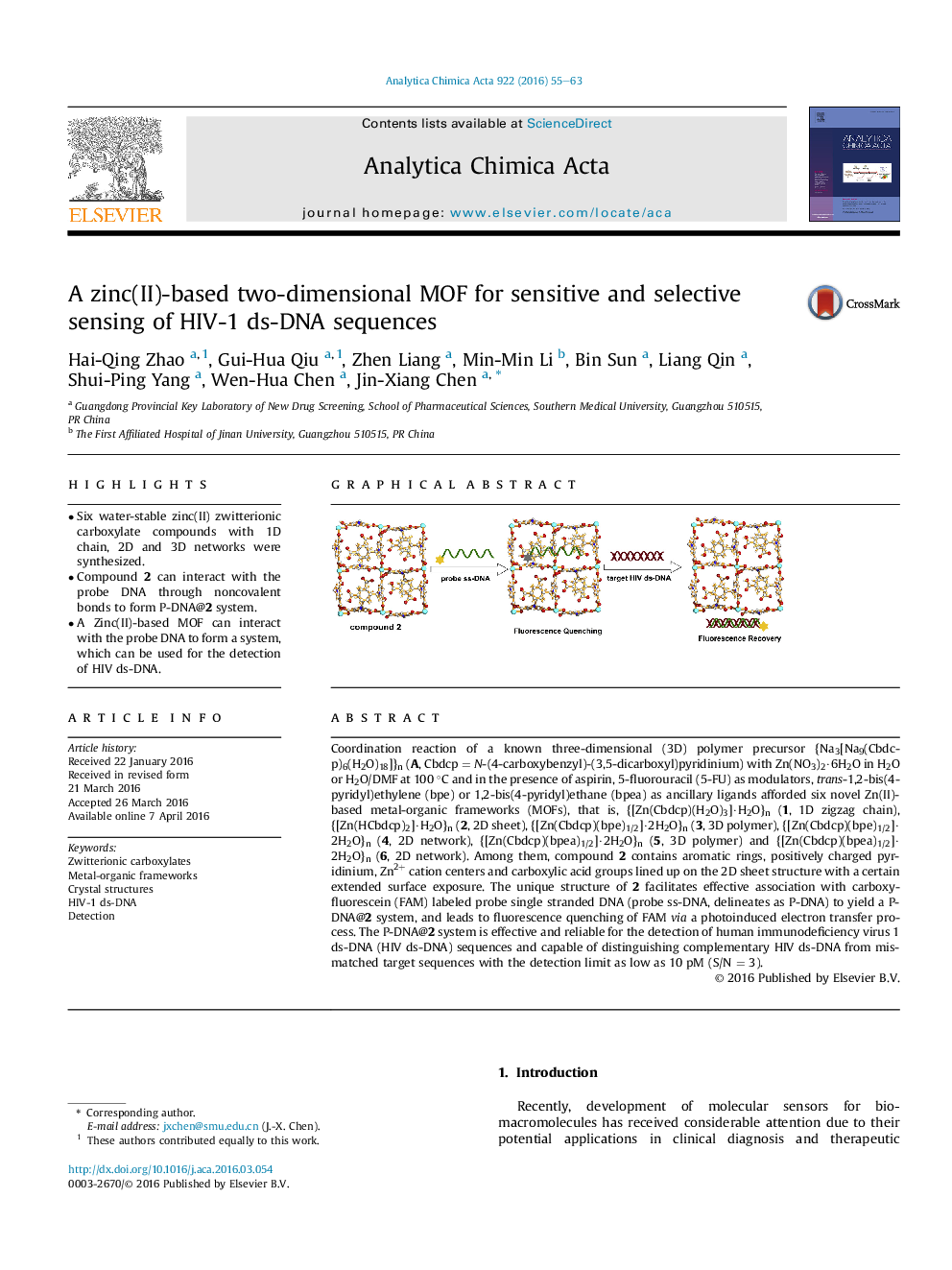| کد مقاله | کد نشریه | سال انتشار | مقاله انگلیسی | نسخه تمام متن |
|---|---|---|---|---|
| 1162999 | 1490910 | 2016 | 9 صفحه PDF | دانلود رایگان |

• Six water-stable zinc(II) zwitterionic carboxylate compounds with 1D chain, 2D and 3D networks were synthesized.
• Compound 2 can interact with the probe DNA through noncovalent bonds to form P-DNA@2 system.
• A Zinc(II)-based MOF can interact with the probe DNA to form a system, which can be used for the detection of HIV ds-DNA.
Coordination reaction of a known three-dimensional (3D) polymer precursor {Na3[Na9(Cbdcp)6(H2O)18]}n (A, Cbdcp = N-(4-carboxybenzyl)-(3,5-dicarboxyl)pyridinium) with Zn(NO3)2·6H2O in H2O or H2O/DMF at 100 °C and in the presence of aspirin, 5-fluorouracil (5-FU) as modulators, trans-1,2-bis(4-pyridyl)ethylene (bpe) or 1,2-bis(4-pyridyl)ethane (bpea) as ancillary ligands afforded six novel Zn(II)-based metal-organic frameworks (MOFs), that is, {[Zn(Cbdcp)(H2O)3]·H2O}n (1, 1D zigzag chain), {[Zn(HCbdcp)2]·H2O}n (2, 2D sheet), {[Zn(Cbdcp)(bpe)1/2]·2H2O}n (3, 3D polymer), {[Zn(Cbdcp)(bpe)1/2]·2H2O}n (4, 2D network), {[Zn(Cbdcp)(bpea)1/2]·2H2O}n (5, 3D polymer) and {[Zn(Cbdcp)(bpea)1/2]·2H2O}n (6, 2D network). Among them, compound 2 contains aromatic rings, positively charged pyridinium, Zn2+ cation centers and carboxylic acid groups lined up on the 2D sheet structure with a certain extended surface exposure. The unique structure of 2 facilitates effective association with carboxyfluorescein (FAM) labeled probe single stranded DNA (probe ss-DNA, delineates as P-DNA) to yield a P-DNA@2 system, and leads to fluorescence quenching of FAM via a photoinduced electron transfer process. The P-DNA@2 system is effective and reliable for the detection of human immunodeficiency virus 1 ds-DNA (HIV ds-DNA) sequences and capable of distinguishing complementary HIV ds-DNA from mismatched target sequences with the detection limit as low as 10 pM (S/N = 3).
Six water-stable zinc(II) zwitterionic carboxylate compounds with 1D chain, 2D and 3D networks were synthesized. Compound 2 can interact with the probe DNA through noncovalent bonds to form P-DNA@2 system. This system can be used as an effective, fluorescent sensing platform for the detection of HIV ds-DNA with the detection limit as low as 10 pM.Figure optionsDownload as PowerPoint slide
Journal: Analytica Chimica Acta - Volume 922, 30 May 2016, Pages 55–63